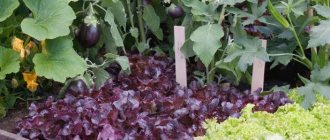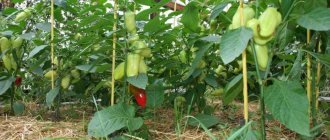Let’s figure out how to intelligently “populate” the entire soil in a greenhouse with vegetables, and at the same time increase productivity.
To get record harvests, residents of the northern regions have to grow heat-loving crops in protected soil. Since building a greenhouse takes a lot of time, effort and finances, we try to use the soil as economically as possible. Therefore, we plant vegetables close to each other.
The wrong choice of neighbors can lead to significant crop losses. To prevent this, you need to carefully consider the design of the beds.
In protected soil, gardeners most often grow tomatoes, cucumbers, peppers and eggplants. But I really want to plant at least a couple of other crops in the empty plots of land. Some plants coexist peacefully with each other, but particularly capricious “invaders” can slow down the development of the main vegetables growing in the greenhouse.
What to plant next to tomatoes
Tomatoes prefer moderate air temperatures, frequent ventilation, fertilizing and abundant watering (be sure to the root!).
Next to them you can plant seedlings of early white cabbage (varieties Miracle ultra-early F1, Express F1, Nakhodka). Leaf and head lettuces (Bright vitamins) will grow well in the “legs”. Also good companions are onions, parsley, watermelon (Sugar Lightning F1), radishes (Sugar Giant). But tomato does not go well with dill and fennel.
By the way, many gardeners make the same mistake: they grow tomatoes and cucumbers next to each other. But the proximity of these cultures is not so harmless. If you don't want to pay for a good harvest, plant them in different corners and separate them with a bed of peppers.
Tomatoes and cucumbers don't get along well with each other
What to plant next to cucumbers
Cucumbers tend to cling to any object with their antennae. And so that they do not damage neighboring plants, they should be grown on a trellis in a greenhouse.
To cucumbers you can add dill, parsley, basil, fennel, leaf and head lettuce, white cabbage (of course, if there is enough space for it), radish, eggplant (varieties Siberian early ripening 148, Mushroom Picker's Dream), sweet pepper (Giganto Rossa F1 , Ural thick-walled F1, Yellow giant F1, Red giant F1, Orange giant F1, Dutch giant, Queen Elizabeth F1).
But the proximity of tomato, watermelon and sage is undesirable for a cucumber.
Radish growing nearby protects cucumbers from leaf beetles and spider mites
Leaders of vegetable crops: tomatoes and cucumbers in one greenhouse
The option of planting cucumbers and tomatoes in one greenhouse is due to the lack of planting space, but does not give an impressive harvest.
The two most popular vegetables, without which a table is unthinkable, are cucumbers and tomatoes. During the summer season, gardeners try not only to grow them for fresh consumption, but also to stock up on canned fruits for the whole winter. These are usually the main greenhouse vegetables. If both vegetables are grown in large volumes for the purpose of sale, then it is better to have a separate greenhouse for each of them. But often amateur gardeners cannot decide which is more important and place tomatoes and cucumbers in the same greenhouse.
This is also possible, but you need to adapt the microclimate of the greenhouse for each vegetable, since their requirements for moisture, heat and ventilation are completely different. Cucumbers prefer a humid, warm climate, but direct sunlight is undesirable. They love this method of watering, such as sprinkling, which tomatoes cannot tolerate at all. In order for them to get along in the same greenhouse, planting should be done so that the plants do not touch each other at all.
If the greenhouse is long enough, you can make a fence inside from polycarbonate, plywood or boards. But for this option it is important that there are also two entrances. When the greenhouse is ventilated from the side of the tomatoes, this will not harm the cucumbers in any way. And when cucumbers are watered, the tomato bushes will not be harmed by the water.
Many summer residents note that when planting tomatoes and cucumbers together, tomatoes suffer more. Their harvest is significantly reduced. Therefore, the best option would be their separate existence.
If you decide to use a greenhouse for tomatoes, you can first plant all the seedlings on the 20th of May in the greenhouse as a nursery, and then leave some of the roots under cover. These can be early varieties for a quick harvest or, on the contrary, late tall varieties to increase the duration of fruiting. Everyone decides for themselves. And the cucumbers will feel comfortable separately - in the garden bed under a film cover.
What to plant next to peppers
All nightshades (peppers, tomatoes and eggplants) can live well together. But some very close plantings will not allow you to get a rich harvest. So, it is better to plant peppers away from eggplants. A successful solution to this problem is to organize the beds in the following sequence: pepper, tomato, eggplant.
You can also plant basil, lovage, cucumber, and onions next to the peppers. But fennel is not suitable for the role of a good neighbor.
Peppers grow well next to tomatoes and cucumbers and a little away from eggplants
What to plant next to eggplants
These plants are quite finicky, so it is not recommended to plant anything next to them, so as not to shade or thicken the plantings. But if every centimeter in the greenhouse is worth its weight in gold, you can “settle” onions, melons and low-growing varieties of tomatoes next to the eggplants.
If eggplants do not develop well in your greenhouse, do not grow them next to other crops.
Use every centimeter of your greenhouse or greenhouse rationally. Grow greens there in early spring. And with the onset of warmth, having enjoyed plenty of vitamin crops, give this place to heat-loving tomatoes, cucumbers, peppers and eggplants.
How to get a rich harvest in greenhouses?
Many people wonder how to properly grow vegetables on their plot. To make growing vegetables in greenhouses as efficient as possible, you need:
- Well thought out and high quality greenhouse design.
- Reliable covering material.
- Automatic systems in the greenhouse.
On average, tomatoes in a greenhouse feel good at air temperatures from +18°C to 22-25°C and soil temperatures from +10°C and above (higher temperatures are maintained during flowering and fruiting).
In a greenhouse, the correct microclimate is a prerequisite.
To create it, you need to make an effort and install automatic systems:
- watering;
- ventilation;
- heating;
- ventilation;
- shading.
In order for growing vegetables in greenhouses to be successful, the following conditions must be present:
- optimal humidity;
- correct temperature day and night;
- adequate ventilation;
- soil containing all the necessary fertilizers, microelements and organic substances;
- proper care.
To achieve such results, you need to know the rules of how to grow vegetables in a greenhouse, and at the same time follow the growing technology. Only then will the quality of the harvest justify the invested effort and money.
Basic rules for growing vegetables in a greenhouse
Correct temperature
In summer, the air temperature in the greenhouse may rise above the permissible limit, which will have a detrimental effect on growing vegetables in it. The vegetables in the greenhouse will wither and there will be no harvest. Air temperature is the most important factor in properly growing vegetables. If the temperature rises above 50 degrees in summer, then vegetables urgently need to be saved. To do this, you need to create shading in the greenhouse or greenhouse in advance. This will save the greenhouse from overheating and raising the air temperature inside.
Cucumbers are very thermophilic, they do not tolerate frost and can die even with a slight drop in temperature.
Watering
An equally important factor in proper cultivation in greenhouses is watering the plants.
Watering rules:
- The water temperature for watering vegetables in the greenhouse must correspond to the soil temperature.
- The ideal irrigation option is drip irrigation.
- If watering is carried out using the traditional method, then water should be poured at the root of the plant.
Plant compatibility
It is worth considering the fact that simultaneous cultivation of vegetables in greenhouses in the neighborhood may be incompatible. This comes from the fact that all plants are different and they need different care, some need plenty of watering, while others, on the contrary, like dry soil, some need high air temperature, and some not so much. And so on. In order for plants to get along together, you need to plant them in accordance with the regime. Otherwise, the yield will be reduced.
Another factor in the proper cultivation of vegetables: before planting a particular crop in a greenhouse, you need to know which predecessor grew in this place. Some crops cannot tolerate soil in which crops that are incompatible with each other grew.
Cucumbers, for example, love high air humidity; they can be watered abundantly without fear for the future harvest. If the greenhouse is dry, the cucumbers will wither. Cucumber leaves evaporate a lot of moisture, so together with cucumbers you need to plant crops that love a humid environment.
Soil for a greenhouse
Compatibility of vegetables according to the abundance of fertilizing
Vegetables grown in greenhouses are very demanding. This applies not only to temperature and humidity, but also to the soil. After all, the soil must contain all useful substances, microelements and organic fertilizers.
The soil needs to be prepared in advance, in the fall.
Its composition should be like this:
- manure;
- hay (straw, weeds and other plant remains);
- turf land;
- peat;
- nitrogen-containing chemical fertilizers;
- carbohydrate-containing chemical fertilizers.
It all depends on what kind of vegetable will grow in the greenhouse.
Tools needed to grow vegetables in greenhouse conditions:
- Watering can.
- Hoe.
- Shovel.
- Rake.
- Scissors.
- Wire.
- Thermometer.
- Irrigation pipes.
- Ventilation holes (fan, air conditioner).
- Pipes or heating devices (heater, radiators, convector).
Technology for preparing high-quality soil and caring for it
Vegetable ripening times.
- You need to remove 30 cm of soil from the greenhouse.
- Lay the first layer with hay, straw, branches, leaves - carbohydrate-containing materials.
- The second layer should be manure or bird droppings.
- Next, cover with peat and turf soil.
- The peat needs to be ventilated so that all substances harmful to vegetables are removed from it.
- The thickness of the top layer must be at least 15 cm.
- It is better to choose low-lying peat; its humidity should be 50-60%.
Soil quality:
- availability of necessary substances;
- the ratio of these substances;
- the presence of beneficial microflora in the soil;
In order for the soil to be of higher quality, it is necessary to grow siderites in greenhouses - plants that will later be used as fertilizers.
If fertilizers were not applied in the fall, they should be applied in the spring, before planting seedlings in greenhouses. You need to pay special attention to soil care.
Fertilizers must be applied in accordance with certain rules:
- Sunflower requires calcium.
- Cauliflower - molybdenum.
- Beetroot - boron.
- Zucchini - iodine.
Useful tips when applying fertilizers to soils
- Dry fertilizers are spread over the surface of the soil using gloves.
- To prevent the leaching of nutrients from the soil, you need to apply fertilizers purposefully, using measured doses.
- Liquid fertilizing is more effective because it can be combined with watering.
- Root feeding is the most effective way to feed a plant with the necessary substances and minerals.
Growing a rich harvest in greenhouses is not only proper care, but also a consequence of proper crop rotation. Many plants are easily susceptible to harmful insects and are susceptible to various diseases, so they need proper care.
Therefore, you can’t plant vegetables anywhere. Everyone should have their own place.
Crop rotation is the correct alternation of vegetables, growing them in the same place. It should be aimed at the highest yield of vegetables during harvest. Three types of crops can be grown on the same soil in a year. Changing the location of crops is necessary to ensure that harmful substances do not accumulate in the soil after harvesting. To be more confident in the quality of the crop, it is necessary to disinfect the soil after each type of crop and replace the soil with a new one.
Each crop must be planted in accordance with climatic conditions. If this is a heat-loving crop, then it is better to plant it in the hot summer, but it should not be grown in winter.
All cultures are divided into:
- basic;
- additional;
Main crops have a long growing season, while additional crops have a short growing season.
Cultures are divided into groups:
- Crops with high nutrient consumption (tomatoes, cabbage, cucumbers, celery, leeks).
- With average nutrient intake (radish, herbs, asparagus, kohlrabi).
- Low nutrient intake (beans).
Correct rotation of planting plants in a greenhouse (crop rotation):
Third group, second group, first group, then third again, second, first and so on. In this order, harmful substances will accumulate in the soil to a minimum. This alternation of plants by species is the most optimal and less dangerous in terms of crop loss.
If the vegetables are not rotated correctly, harmful bacteria, microorganisms, pests and diseases will accumulate in the greenhouse, and the yield will decrease with each season. In this case, a large amount of money, effort and time will need to be spent on replacing the soil and controlling pests.
Another principle for dividing all plants:
- Root vegetables (potatoes, carrots, beets, onions, garlic).
- Leafy (cabbage, asparagus, spices).
- Fruits (pepper, tomato, cucumber).
Unlike growing tomatoes in a greenhouse, high air humidity is very important for cucumbers. On sunny days it should be at least 85%, on cloudy days - at least 70%.
In this case, the alternation should take place according to the following scheme: leaf, root, fruit, leaf, root, fruit, and so on.
All plants are divided into the following families:
- Pumpkin (zucchini, pumpkin, cucumbers, melon, watermelon).
- Chenopodiaceae (beets, spinach).
- Umbelliferae (parsley, celery, carrots).
- Cruciferous vegetables (cabbage, rutabaga, radishes).
- Compositae (lettuces, chicory).
- Nightshades (eggplant, tomatoes, peppers).
Based on this, cultures of the same family should not replace each other.
Secrets of crop rotation
Tomatoes are not grown after crops such as cucumbers, eggplants, potatoes, peppers. The best predecessors of tomatoes are: onions and beans.
Cucumbers should not be grown in greenhouses after melon, watermelon, and zucchini. The best option is after onions and radishes.
Cabbage should not be planted after sorrel, parsley and spinach. Optimally - after onions, garlic, carrots, beets.
Beans should not be planted after beans. And onions will grow most optimally after carrots, flowers, cabbage and cucumbers.
To be sure of all of the above, you need, of course, practice. Each vegetable grower must have his own technology, theory, practice, care, as well as his own secrets and highlights.
ParnikiTeplicy.ru











